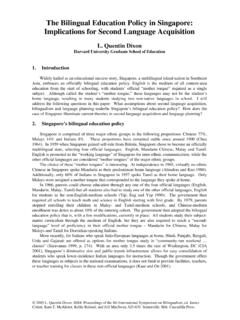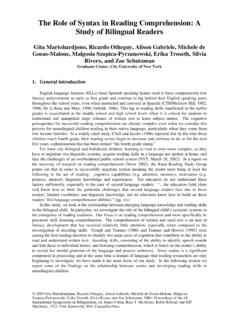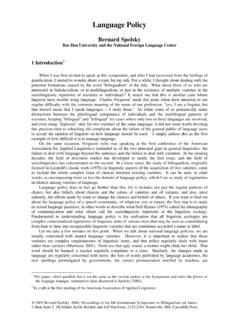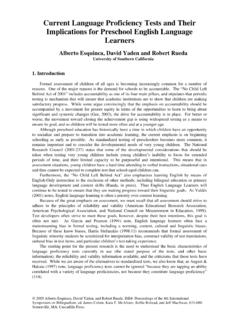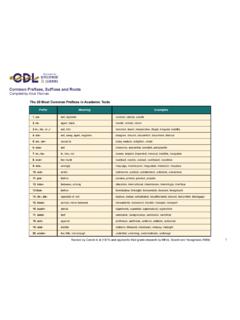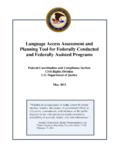Transcription of Namibia: A Case for a Gradual Transitional Bilingual ...
1 Namibia: A Case for a Gradual Transitional Bilingual language programme Dolores Wolfaardt Ministry Of Basic Education, Sport And Culture: Namibia 1. Introduction Namibia is a relative small country on the southwestern part of Africa just north west of South Africa. Namibia has a population of just over 1,7 million people and became independent from South Africa in 1990. Although a mere 0,8% of the population are in fact first language speakers of English, English was chosen by SWAPO (Southwest Africa People s Organisation), the ruling party, as the official language after Namibia s independence in 1990 for various reasons that are outlined in Towards a language policy for Namibia (UNIN, 1981).
2 This was overall not an unpopular choice. This decision was outlined Article 3 ( language ) in the Constitution (MIB 1990:3) and also in The language Policy for Schools 1992 1996 and beyond (MEC 1993). The African Languages and English as the official language for Namibia were already recognised as equal in status in 1980 at a conference held in Lusaka at the United Nations Institute for Namibia (UNIN 1981). These languages can be seen as the two focal points around which language planning in education has operated in Namibia. My work at the Directorate of National Examinations and Assessment of the Ministry of Basic Education, Sport and Culture concerns the daily assessment of learners and our workday is spent on ongoing engagement with how learners learn, how successful they are in learning and how learning can best be evaluated.
3 The results of the language policy are reflected in the performance of the learners in the external assessment in Grade 10 and 12. I observed that the learners were not performing as well as expected and it seemed that they were struggling with the new medium of instruction. My study took the National language Policy as point of departure to demonstrate the role that this policy plays in facilitating learning in the classroom. The focus was thus on the way English as medium of instruction is implemented, particular in the Upper Primary phase (Grades 4 7). The following questions were very important to my research: Does the current language policy make learning possible?
4 Do most teachers have the confidence and proper English language proficiency to teach in English as medium of instruction? To what degree does Namibian teachers revert to mother tongue as medium of instruction when they teach to express themselves? Will a Bilingual language policy, where both English and the mother tongue are used, as medium of instruction, be able to improve the learner s proficiency in English? 2. Background Throughout our country s history the medium of instruction played a major role. During the pre-independence era the target language of learning (Afrikaans) undermined the self-concept and cognitive growth of the African language speakers.
5 From this era the notion was born that the African languages are deficient and resistance built up against the notion of mother tongue as medium of instruction in education. Among African language speakers, the notion that English was the key to empowerment therefore grew ever stronger (Heugh 1995:43). After independence in 1990, the Ministry of Basic Education realised that a new language policy for schools was urgently needed. This policy had to promote the use of the mother tongue and English 2005 Dolores Wolfaardt. ISB4: Proceedings of the 4th International Symposium on Bilingualism, ed.
6 JamesCohen, Kara T. McAlister, Kellie Rolstad, and Jeff MacSwan, 2357-2368. Somerville, MA: Cascadilla schools and in teacher training colleges. As a result, the document The language policy for schools: 1992 1996 and beyond (MEC 1993) was formulated and implemented. The national language policy for schools in Namibia (MEC 1993) stipulates that the medium of instruction in Grades 1 3, the Junior Primary phase, should be the mother tongue and English will be taught as a subject and from Grade 4 onwards the medium of instruction should change to solely English.
7 The Namibian language policy as published (MEC 1993) is a combination of an additive and subtractive model of language in education policy. During the initial implementation, the policy followed a Gradual transition or late-exit language programme . Currently, it is a subtractive or early-exit language programme . This policy was not explicit in its guidelines on how the different mother tongues should be used in schools. The policy mainly spelt out how the phasing in of English as medium of instruction between 1992 and 1996 should be achieved.
8 In the draft language policy for schools and colleges of education (Ministry of Basic Education, Sport and Culture [MBESC] 2001:3) that was a result of the conference proceedings, the implementation of the first policy was criticised in the following way: There were discrepancies in the implementation of the language policy from region to region, as policy implementers, due to misinterpretation and manipulation, mainly preferred teaching through English rather than through the mother tongue. Formerly disadvantaged learners were further marginalized in this process, as non-English speaking teachers were expected to teach through the medium of English.
9 There is some disjuncture between the criteria and the goals of the policy in that the criteria do not spell out that it is not permissible for a school to use the mother tongue as medium of instruction up to Grade 6 or 7. Although the language policy states that the mother tongue should be used as the medium of instruction in Grades 1 to 3 there is a provision that allows schools to opt out, if the necessary resources are not available. The policy also lacks discussion of the role of education promoting language and cultural identity through the mother tongue.
10 Some education planners and parents adhered to the assumption that the earlier a child is confronted with a foreign language (English), the sooner the language will be mastered and therefore many Namibian primary schools opted for English as medium of instruction from Grade 1. There is no unanimity among Namibians regarding mother tongue being used as medium of instruction, if the opinion of the different regions can be interpreted as a tendency. It is important to note, that for example, people living in the rural areas are more in favour of their mother tongue being used as medium of instruction than people living in urban areas (Leg re 1995:132 293) It is also interesting to note that in the more homogeneous regions, more than 80% of lower primary schools have an African language , the inhabitants home language , as medium of instruction.
